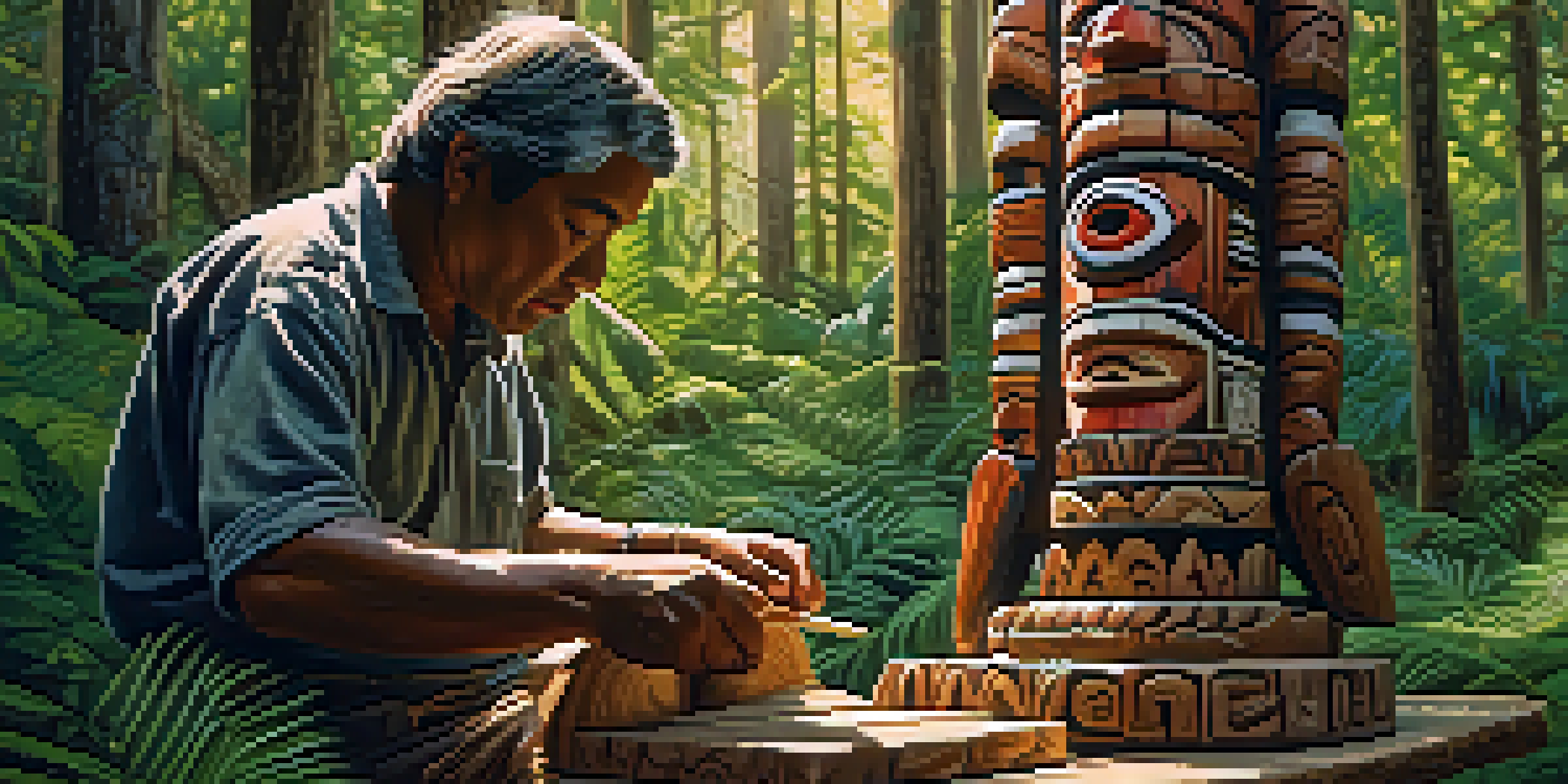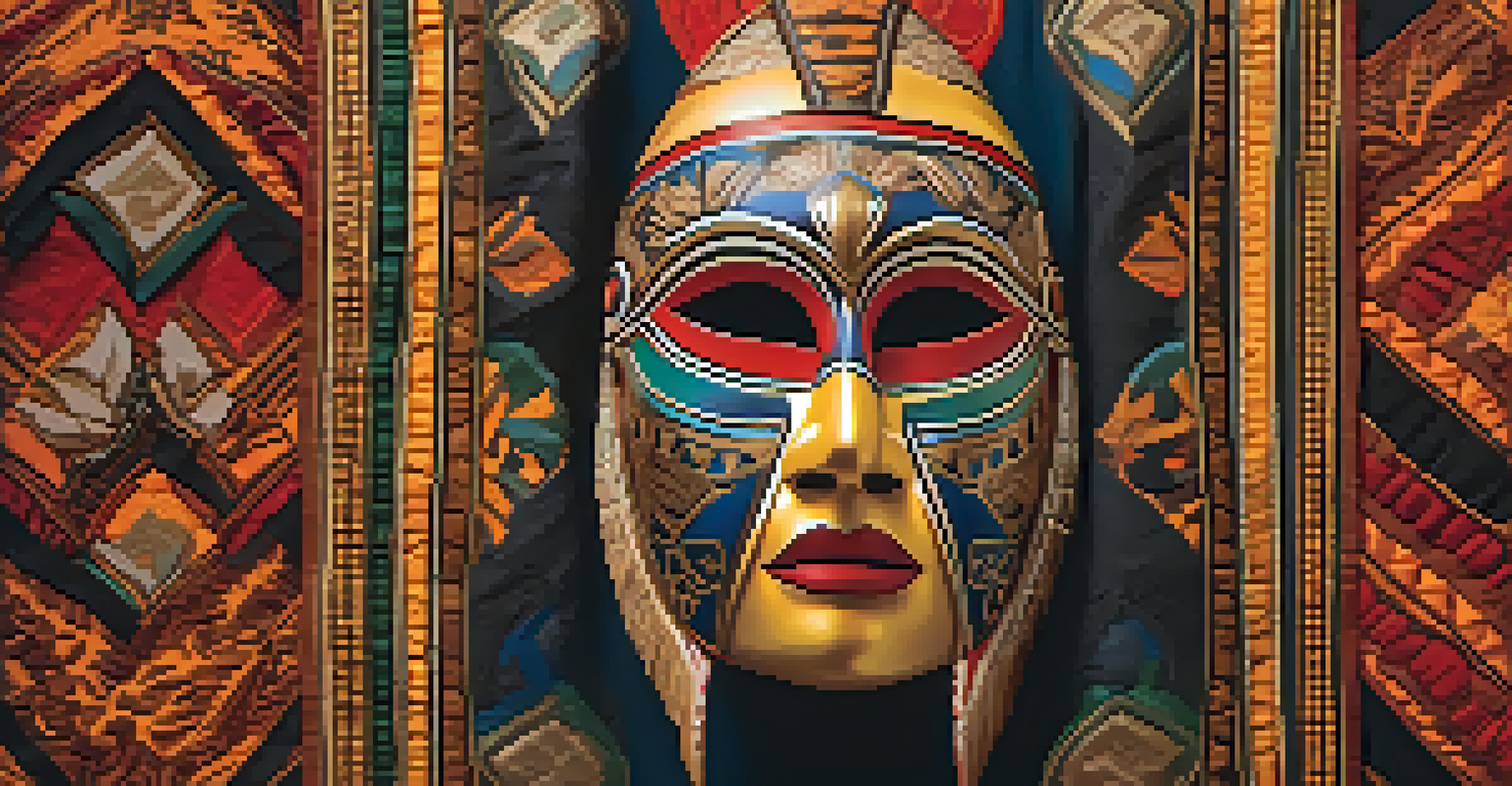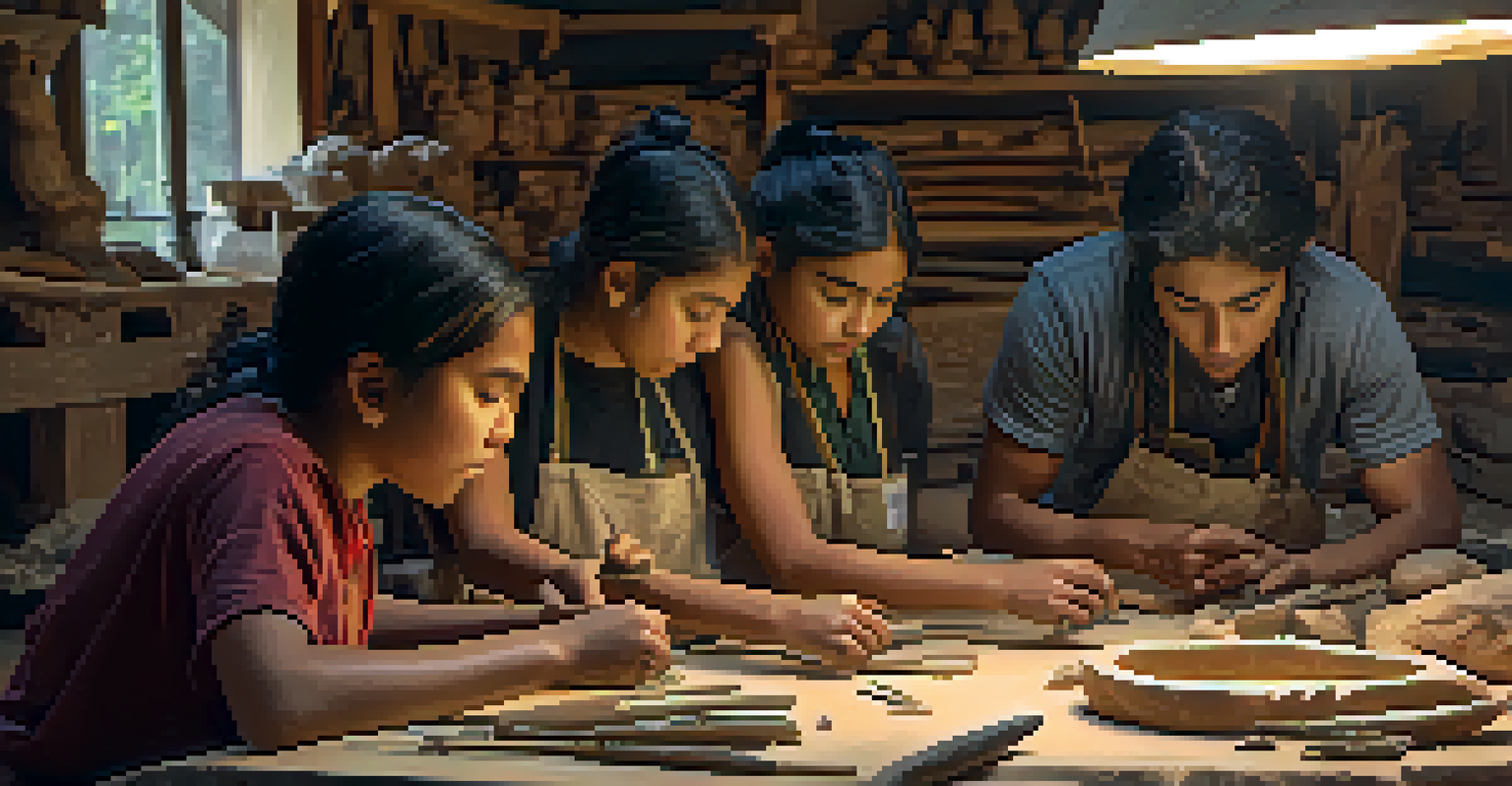The Spiritual Significance of Carving in Indigenous Traditions

Understanding Carving in Indigenous Cultures
Carving is more than just a form of art; it reflects the cultural heritage of Indigenous peoples. Each piece, whether a totem pole or a ceremonial mask, tells a unique story that connects the maker to their ancestors and community. This practice has been passed down through generations, embodying the spiritual teachings and beliefs of the people.
The carving of wood, stone, or bone is not merely about the material; it is about the spirit that resides within, waiting to be revealed through the artisan's touch.
For Indigenous cultures, carving is often a way to communicate with the spirit world. The act of carving itself is seen as a sacred ritual, where artisans channel their energy and intentions into their work. This makes each piece not just a visual object but a vessel of spiritual significance.
Moreover, these carvings serve as a bridge between the past and present. They help keep traditions alive, allowing younger generations to learn about their identity and the teachings of their ancestors. In essence, carving becomes a living expression of culture and spirituality.
The Role of Nature in Carving Practices
In many Indigenous cultures, nature plays a pivotal role in the carving process. The materials chosen, such as wood, stone, or bone, are often sourced from the local environment, reflecting a deep respect for the land. This connection to nature not only influences the aesthetics of the carvings but also imbues them with spiritual meaning.

For instance, a carver may select a particular type of wood because it is believed to have protective qualities. This choice enhances the piece's significance, as it becomes an embodiment of the natural world’s spiritual attributes. The materials themselves are viewed as alive, carrying their own stories and energies.
Carving Reflects Cultural Heritage
Indigenous carving is a profound art form that connects artisans to their ancestors and community, embodying spiritual teachings and cultural identity.
Additionally, the relationship between the carver and the materials is often likened to a conversation. Just as one might listen to a friend, a skilled carver listens to the wood or stone, understanding how to honor its unique qualities. This dialogue is integral to creating meaningful works that resonate on a spiritual level.
Symbolism in Indigenous Carvings
Symbolism is at the heart of Indigenous carving practices. Each design, motif, and figure has a specific meaning, often related to cultural stories, spiritual beliefs, or natural elements. For example, animals may represent certain qualities or teachings, making their portrayal in carvings rich with significance.
Art is the most beautiful of all lies; it is the most profound of truths. In carving, we find the intersection of both.
Take the bear, for instance; in many Indigenous cultures, the bear symbolizes strength and courage. When carved into a piece, it serves as a reminder of these attributes, not only for the maker but for the community that interacts with the artwork. Such symbols create a shared language that fosters connection and understanding.
Moreover, the layers of symbolism often invite viewers to reflect on their own lives. Engaging with these carvings can inspire personal introspection, allowing individuals to explore their own relationships with nature, culture, and spirituality. In this way, carving transcends mere aesthetics; it becomes a source of insight and wisdom.
Ceremonial Significance of Carved Objects
Many carved objects hold ceremonial significance in Indigenous cultures. They are often used in rituals, celebrations, or healing practices, serving as important tools to connect with the spiritual realm. For instance, masks may be worn during dances to invoke the presence of ancestors or spirits.
These ceremonies are deeply rooted in community and tradition, where the act of carving and using these objects fosters a sense of belonging and continuity. Each ceremony is a reminder of the shared history and collective identity of the community, reinforcing bonds among participants.
Nature Influences Carving Practices
The choice of materials in carving reflects a deep respect for nature, with each element carrying its own spiritual significance and story.
Furthermore, the spiritual energy infused in these carved objects often enhances the ceremony's impact. Participants may feel a deeper connection to their heritage and the spiritual world, making the experience not only meaningful but transformative. This highlights the power of carving in bridging the material and spiritual realms.
The Preservation of Carving Traditions
With the passage of time, many Indigenous carving traditions face the threat of fading away. Factors like globalization, cultural assimilation, and loss of natural resources have led to a decline in these practices. However, many communities are actively working to preserve and revitalize their carving traditions.
Efforts to document techniques, share stories, and teach younger generations are crucial in keeping these traditions alive. Workshops and collaborative projects bring together experienced carvers and novices, fostering an environment of learning and sharing. This not only preserves the art form but also strengthens community ties.
Additionally, modern technology plays a role in preservation. Digital platforms allow Indigenous artists to showcase their work to a broader audience, raising awareness and appreciation for their cultural heritage. By embracing both tradition and innovation, Indigenous communities are finding new ways to honor their carving practices while ensuring their survival.
Carving as a Form of Storytelling
At its core, carving is a powerful form of storytelling in Indigenous cultures. Each carving conveys narratives that encapsulate history, lessons, and moral values. This storytelling aspect is vital, as it keeps the culture alive and relevant to contemporary audiences.
Through visual imagery, carvers can depict legends, personal experiences, or communal memories. This not only preserves these stories but also invites viewers to engage with them, fostering a deeper understanding of the culture. In this way, carving becomes a dialogue between the past and present.
Carving as Storytelling Medium
Carvings serve as powerful storytelling tools that preserve cultural narratives, inviting viewers to connect with and reflect on their own experiences.
Moreover, storytelling through carving often encourages reflection and connection. Viewers may find themselves relating to the depicted stories, allowing them to explore their own experiences and emotions. This shared narrative creates a sense of unity, demonstrating the universal power of storytelling across cultures.
The Future of Indigenous Carving Traditions
The future of Indigenous carving traditions is filled with both challenges and opportunities. As communities work to preserve their heritage, there is a growing recognition of the importance of these practices in contemporary society. Increased interest in Indigenous art and culture creates a supportive environment for renewal.
Young artists are stepping up, infusing traditional techniques with modern influences. This blend of old and new not only keeps the practice alive but also allows it to evolve, reflecting the dynamic nature of culture. Such innovation ensures that carving remains relevant and resonant for future generations.

Ultimately, the future of Indigenous carving traditions hinges on community resilience and adaptability. By embracing both their rich history and the potential for growth, Indigenous peoples can continue to share their stories and spiritual significance through carving, enriching the cultural tapestry of the world.